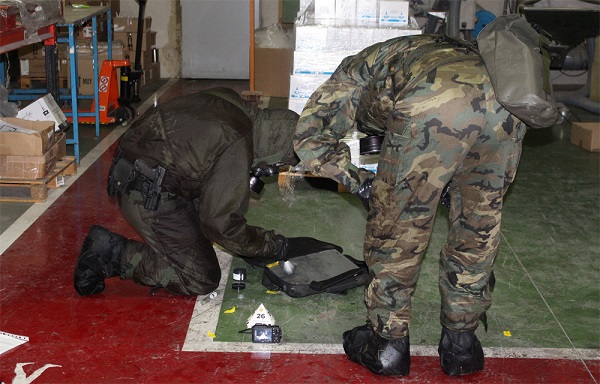- Hastapen
- NBC units and teams train in the 'First Defender' exercise in Valencia
NBC units and teams train in the 'First Defender' exercise in Valencia
miércoles 6 de junio de 2018
Zenbakia: 6712
The 1st NBC Defense Regiment, together with units and equipment from the Special Operations Command, Engineers Command, Signals Command, the 1st Intelligence Regiment and Military Police Battalion, trained from the 1st to the 3rd of June in the "First Defender" exercise in Paterna (Valencia).
The aim of the operation was to take down a clandestine insurgency network, which sought to produce large-scale terrorist attacks using industrial chemicals. The terrorists camouflaged themselves in a large 20,000 m2 glue and adhesive factory that was guarded day and night for 36 hours before the assault was carried out.
Once the insurgent personnel had been captured and secured inside the factory, the search for the material used by the insurgents at the factory began, finding a truck ready to detonate and produce a chemical cloud; a refrigerated chamber that concealed dual-use chemicals, the inventory of which had been manipulated to conceal the theft; and a workshop for the preparation of improvised explosive devices.
The Main Command Post, located in the Daoíz y Velarde base in Paterna (Valencia), was composed of personnel managing the traditional areas of a command post, supported by liaison officers from all participating units. The objective was a real glue factory located in the "Juan Carlos I" industrial estate in Almussafes, 30 kilometres from Paterna.
Each acting team contributed its specific capabilities to exploit the scenario in a Multidisciplinary Team, so that an NBC team searched, detected and identified the aggresive chemicals; an Explosive Deactivation Team recognized and deactivated all explosive threats; and a Military Police WIT (Weapon Intelligence Team) team, accompanied by an Intelligence specialist, collected forensic and biometric evidences from each scenario. Personnel who had been soiled or contaminated were subsequently decontaminated, while all the documentation, computer equipment, explosives, and forensic samples were analyzed or sent to higher-level laboratories.
Very interesting lessons were learnt from the exercise, which should be applied in subsequent exercises, such as the need to improve the sending of images/video between the different Command Posts to improve situational awareness, and to alleviate the workload of the chief, focusing more on the exploitation of the objective.

Search for evidence in the exercise (Photo:RDNBQ nº 1)
EJERTZITOAREN UNITATEAK
- Araba Álava |
- Albacete |
- Alicante |
- Almería |
- Asturias |
- Ávila |
- Badajoz |
- Barcelona |
- Burgos |
- Cáceres |
- Cádiz |
- Cantabria |
- Castellón |
- Ceuta |
- Ciudad Real |
- Córdoba |
- A Coruña |
- Cuenca |
- Girona |
- Granada |
- Guadalajara |
- Gipuzkoa |
- Huelva |
- Huesca |
- Islas Baleares |
- Jaén |
- León |
- Lleida |
- Lugo |
- Madrid |
- Málaga |
- Melilla |
- Murcia |
- Navarra |
- Ourense |
- Palencia |
- Las Palmas |
- Pontevedra |
- La Rioja |
- Salamanca |
- Segovia |
- Sevilla |
- Soria |
- Tarragona |
- Santa Cruz de Tenerife |
- Teruel |
- Toledo |
- Valencia |
- Valladolid |
- Bizkaia |
- Zamora |
- Zaragoza



